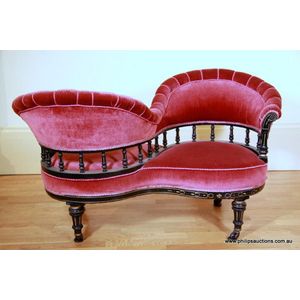Mahogany Balloon Back Chair with Floral Crest
You must be a subscriber, and be logged in to view price and dealer details.
Subscribe Now to view actual auction price for this item
When you subscribe, you have the option of setting the currency in which to display prices to $Au, $US, $NZ or Stg.
- Victorian Period - The Victorian period of furniture and decorative arts design covers the reign of Queen Victoria from 1837 to 1901. There was not one dominant style of furniture in the Victorian period. Designers used and modified many historical styles such as Gothic, Tudor, Elizabethan, English Rococo, Neoclassical and others, although use of some styles, such as English Rococo and Gothic tended to dominate the furniture manufacture of the period.
The Victorian period was preceded by the Regency and William IV periods, and followed by the Edwardian period, named for Edward VII (1841 ? 1910) who was King of the United Kingdom and the British Dominions and Emperor of India for the brief period from 1901 until his death in 1910. - Serpentine - Resembling a serpent, in the form of an elongated 'S'. A serpentine front is similar to a bow front, except that the curve is shallow at each end, swelling towards the middle. The term presumably derives from its similarity to a moving snake or serpent. Serpentine fronts are usually veneered, with the carcase either being cut and shaped from a solid piece of timber, or built in the 'brick' method.
- Mahogany - Mahogany is a dense, close grained red-coloured timber from the West Indies and Central America. It was first imported into Europe in the the early 18th century and its use continued through the 19th century. It was popular for furniture making because of its strength, the wide boards available, the distinctive grain on some boards, termed flame mahogany and the rich warm colour of the timber when it was polished.. The "flame" was produced where a limb grew out from the trunk of the tree, and this timber was usually sliced into veneers for feature panels on doors, backs and cornices.
Some terms used to describe mahogany relate to the country from which it originally came, such as "Cuban" mahogany, "Honduras" mahogany etc. However unless the wood has been tested the names assigned are more a selling feature, rather than a true indication of the timber's origin. - Fluting - A form of decoration found on many pieces of furniture, as well as ceramics, silver and clocks, in which round-bottomed grooves, of varying width and depth, are let into columns, pilasters, legs. As a general rule, flutes are cut in the vertical, though they may follow a turned leg in a spiral pattern. In cross-section, they may be described as a series of 'U' shapes, rising and narrowing at each end of the groove. Fluting is the opposite of reeding, with which fluting is often associated.
This item has been included into following indexes:
Visually similar items

A set of six Louis XV style upholstered oak chairs, circa 1940s, the square back chairs each with a camel hump crest to a stuffover seat, a serpentine apron and raised on cabriole legs with scrolled feet; upholstered in deep mushroom pink velvet. Height 10

A Victorian ebonised love seat, late 19th century, the 'S' form upholstered tete à tete sofa, the back with a padded rolled frame with a rope twist motif, spindles to the lower back, lightly engraved to the seat frame and raised upon tapering fluted legs w

A Victorian mahogany open arm gentleman's chair, 19th century, the tablet shaped button back chair with a showframe and carved crest to open shaped and padded arms to a serpentine seat, the curvaceous arm supports flowing to scrolling legs with carved knee

A set of eight oak 'Mutton Bone' chairs, circa 1920, with a padded arched back and stuff over seat in red velvet and button studs, supported on curved and stylised bone shaped legs with conforming stretchers. Height 99.5 cm. Width 42 cm. Depth 41 cm
